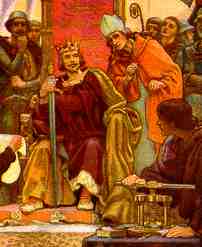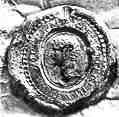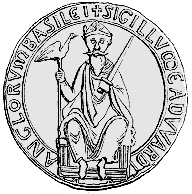 |
|
Royal
Seals |
On
legal documents and letters, the seal
was a ratification of authenticity. On closed up letters, the seal served
to ensure that the letter arrived unopened and untampered with. On official
documents delivered open, the seal, displayed either on the face of he
document or hanging from it on parchment
strips or cords, served to verify the agreement of interested parties
to the document. The seal served in place of an autograph signature. This
practical and legal function did not prevent the seal from becoming an
art form in its own right. Seals became exquisitely crafted and in many
cases, very elaborate. |
|
A
seal was created from a carved matrix which was used to stamp the design
into warm sealing wax. This really makes the matrix the authenticating
instrument, as all seals from the matrix are identical in design. The
matrices could range from a small stamp, as on a signet ring, to a double
sided mould operated in a press, necessary to produce such monumental
objects as the great
seal of England. |
|
| A
schoolbook image of the great seal press. Bad King John in the background,
of course. At least they don't show him signing Magna Carta. |
| A similar seal press to the one shown above, mounted on a hefty oak block, survives in the library of Canterbury Cathedral. |
|
The
earliest imperial seals were produced in direct imitation of the image of
the emperor on Roman coins. |
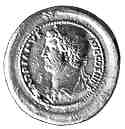 |
On
the left, a bronze 2nd century Roman coin of the Emperor Hadrian. On the right
a seal attached to the face of a diploma of Louis the German, of 856 (St Gall,
Stiftsarchiv, Urkunden F.F.1.H.106). |
|
|
In
the above example the resemblance of Louis the German in profile to the Emperor
Hadrian is not coincidental, as the seal was evidently impressed from a Roman
carved gemstone bearing the emperor's head. Around the edge is an inscription
reading XPE PROTEGE HLVDOICVM REGEM (Christ protect
Ludwig the king), thereby appropriating the image to the Germanic cause. These
seals were single sided and attached to the face of the document. |
|
Solemn
diplomas in Anglo-Saxon
England were not ratifed by seal, but by crosses which were drawn beside
the names of the witnesses. The earliest examples in England of ratification
by seal are writs
of Edward the Confessor. Some important and solemn documents after the
Norman Conquest have both crosses and seal, but the former was abandoned
and the seal became the absolute validating instrument. |
|
Royal
and imperial seals steadily became more majestic and complex. The great
seal of Edward the Confessor was reportedly derived from the seal of Otto
III, showing the monarch seated in majesty. However, Edward went one better
and had the seal made double sided so that it was a large and impressive
object that hung down from the document, rather than attached to the face
of the page in the manner of imperials seals of that date. |
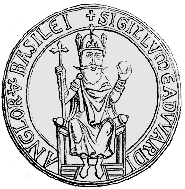 |
Representations of the two sides of the great seal of Edward the Confessor. |
|
|
Each side of ther seal shows him seated, bearing
attributes of kingship. These little drawings appear to have been made from
what is now known to be a forged seal made in the 12th century, but comparison
with the battered remains of the few surviving examples suggests that the
forgers were pretty accurate. |
|
The
basic form of an appropriate image surrounded by an inscription continued
through many elaborations, making the seal a combination of visual imagery
and the written word. |
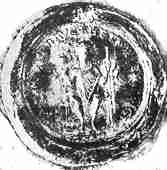 |
The
seal of Emperor Henry III, on a diploma of 1053 (Coblenz, Königlich Preussisches
Staatsarchiv). |
|
This
seal, a little difficult to make out, shows the emperor in majesty holding
a sceptre and a bunch of lilies. It was attached to the face of the document.
Later imperial seals were hung, like papal bullae,
from the bottom of the document on silk cords. |
 |
The
two sides of the great seal of William the Conqueror. |
|
|
The
two sides of the great seal of William the Conqueror bore different images,
one of the king seated on his throne with attributes of kingship, the other
showing him mounted on a horse. The inscription on the equestrian side identifies
him as ruler of Normandy and on the other as king of England. It has also
been suggested that these represent two aspects of kingship, the dispenser
of justice and the leader into battle. Whatever the significance, the basic
scheme remained in use for kings of England, and also kings of Scotland, throughout
the medieval period. |
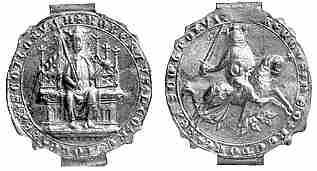 |
The
two sides of the seal of Robert Bruce. The throne has become more elaborate,
as has the armour and the horse trappings, but the imagery is the same. |
|
continued |
 Seals Seals |
 Decoration Decoration |
|
 |
 |
 |
 |
 |
 |
